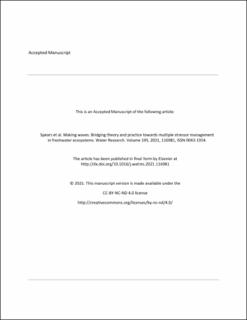| dc.contributor.author | Spears, Bryan M. | |
| dc.contributor.author | Chapman, Daniel S. | |
| dc.contributor.author | Carvalho, Laurence | |
| dc.contributor.author | Feld, Christian K. | |
| dc.contributor.author | Gessner, Mark O. | |
| dc.contributor.author | Piggott, Jeremy J. | |
| dc.contributor.author | Banin, Lindsay F. | |
| dc.contributor.author | Gutiérrez-Cánovas, Cayetano | |
| dc.contributor.author | Solheim, Anne Lyche | |
| dc.contributor.author | Richardson, Jessica A. | |
| dc.contributor.author | Schinegger, Rafaela | |
| dc.contributor.author | Segurado, Pedro | |
| dc.contributor.author | Thackeray, Stephen J. | |
| dc.contributor.author | Birk, Sebastian | |
| dc.date.accessioned | 2022-01-19T11:26:40Z | |
| dc.date.available | 2022-01-19T11:26:40Z | |
| dc.date.created | 2022-01-12T12:26:11Z | |
| dc.date.issued | 2021 | |
| dc.identifier.citation | Water Research. 2021, 196, 116981. | en_US |
| dc.identifier.issn | 0043-1354 | |
| dc.identifier.uri | https://hdl.handle.net/11250/2838216 | |
| dc.description | Embargo until February 26, 2023 | en_US |
| dc.description.abstract | Despite advances in conceptual understanding, single-stressor abatement approaches remain common in the management of fresh waters, even though they can produce unexpected ecological responses when multiple stressors interact. Here we identify limitations restricting the development of multiple-stressor management strategies and address these, bridging theory and practice, within a novel empirical framework. Those critical limitations include that (i) monitoring schemes fall short of accounting for theory on relationships between multiple-stressor interactions and ecological responses, (ii) current empirical modelling approaches neglect the prevalence and intensity of multiple-stressor interactions, and (iii) mechanisms of stressor interactions are often poorly understood. We offer practical recommendations for the use of empirical models and experiments to predict the effects of freshwater degradation in response to changes in multiple stressors, demonstrating this approach in a case study. Drawing on our framework, we offer practical recommendations to support the development of effective management strategies in three general multiple-stressor scenarios. | en_US |
| dc.language.iso | eng | en_US |
| dc.publisher | Elsevier | en_US |
| dc.rights | Attribution-NonCommercial-NoDerivatives 4.0 Internasjonal | * |
| dc.rights.uri | http://creativecommons.org/licenses/by-nc-nd/4.0/deed.no | * |
| dc.title | Making waves. Bridging theory and practice towards multiple stressor management in freshwater ecosystems | en_US |
| dc.type | Peer reviewed | en_US |
| dc.type | Journal article | en_US |
| dc.description.version | acceptedVersion | en_US |
| dc.source.pagenumber | 6 | en_US |
| dc.source.volume | 196 | en_US |
| dc.source.journal | Water Research | en_US |
| dc.identifier.doi | 10.1016/j.watres.2021.116981 | |
| dc.identifier.cristin | 1979353 | |
| dc.relation.project | EC/FP7/603378 | en_US |
| dc.source.articlenumber | 116981 | en_US |
| cristin.ispublished | true | |
| cristin.fulltext | postprint | |
| cristin.qualitycode | 2 | |

